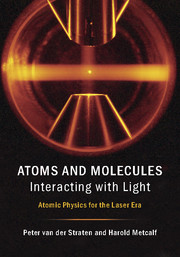Book contents
19 - Optical forces and laser cooling
from Part III - Applications
Published online by Cambridge University Press: 05 February 2016
Summary
The usual form of electromagnetic forces is given by but for neutral atoms q = 0. The next order of force is the dipole term, but this also vanishes because neutral atoms have no inherent dipole moment. However, a dipole moment can be induced by a field, and this is most efficient if the field is alternating near the atomic resonance frequency. Since these frequencies are typically in the optical range, dipole moments are efficiently induced by shining nearly resonant light on the atoms.
Laser cooling and trapping rely on the interaction between laser light and atoms to exert a controllable force on the atoms, and many sophisticated schemes have been developed using the special properties of the interaction. This chapter begins with the simplest schemes for exerting optical forces on atoms, namely a single-frequency light field interacting with a two-level atom. Although this is the simplest possible scheme, it is pedagogically valuable because it shows many of the features that will be encountered further on. The ultimate temperature using such a scheme is limited, but lower temperatures can be achieved with multilevel atoms. This topic is addressed later in the chapter.
Two kinds of optical forces
When an atom absorbs nearly resonant light, it makes a transition to the excited state, and its subsequent return to the ground state can be either by spontaneous or by stimulated emission. The nature of the optical force that arises from these two different processes is quite different, and will be described separately [1]. The spontaneous emission case is different from the familiar quantum mechanical calculations using state vectors to describe the state of the system, because spontaneous emission causes the state of the system to evolve from a pure state into a mixed state (see Exercise 6.9). Spontaneous emission is an essential ingredient for the dissipative nature of the optical forces in monochromatic light, and the density matrix is needed to describe it (see Chap. 6).
When an atom absorbs light, its energy excites the atom and its angular momentum changes the electron's orbit. Both of these are internal atomic properties. However, the linear momentum of the light, can change only the external, translational motion of the atom.
- Type
- Chapter
- Information
- Atoms and Molecules Interacting with LightAtomic Physics for the Laser Era, pp. 347 - 366Publisher: Cambridge University PressPrint publication year: 2016



